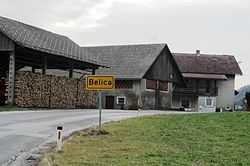Belica, Dobrova–Polhov Gradec
| Belica | |
|---|---|
 | |
_location_map.svg.png) Belica | |
| Coordinates: 46°4′28.09″N 14°21′7.34″E / 46.0744694°N 14.3520389°ECoordinates: 46°4′28.09″N 14°21′7.34″E / 46.0744694°N 14.3520389°E | |
| Country |
|
| Traditional region | Upper Carniola |
| Statistical region | Central Slovenia |
| Municipality | Dobrova–Polhov Gradec |
| Area | |
| • Total | 1.73 km2 (0.67 sq mi) |
| Elevation | 551.1 m (1,808.1 ft) |
| Population (2002) | |
| • Total | 43 |
| [1] | |
Belica (pronounced [ˈbeːlitsa]) is a small settlement east of the town of Polhov Gradec in the Municipality of Dobrova–Polhov Gradec in the Upper Carniola region of Slovenia.[2] It lies on the left bank of the Gradaščica River on the road from Ljubljana to Polhov Gradec, bounded by Rabidovš Hill (520 m) to the north and Črtež Hill (480 m) to the northwest.[3]
Name
The name Belica literally means 'white (creek)'. Belica was first mentioned in written sources in 1303 under the German name Weissempach (literally, 'white creek'), and in 1436 with the Slovene name represented as Welcz. In the 19th century it was known as Belza in German.[4] Like most Slovene places called Belica, this name is also derived from a hydronym, as reflected in Belca Creek, which flows through the settlement.[5]
History
A bronze plaque in the Belca Gorge (Slovene: Belška grapa) above Belica has cultural heritage status. This memorial commemorates the Second World War Partisan First Battalion of the Dolomite Detachment. The bronze plaque was installed to replace an earlier stone plaque, and it reads: "Passersby, pause. In the Belca Gorge on 19 March 1943, 22 men from the First Battalion of the Dolomite Detachment of the National Liberation Army and Partisan Detachments of Slovenia, including the commandant of the battalion, the people's hero Vladimir "Lado" Dolničar, a.k.a. Rudi, fell in a battle with the Italians, Germans, and White Guard."[6] Dolničar committed suicide after being seriously injured in order to evade capture.[7]
In August 1963, the Belca Gorge was the site where the anti-communist revolutionary Janez Toplišek (1930–1965) was ambushed by the Yugoslav secret police and taken into custody.[8] Toplišek had crossed the border from Austria with weapons and propaganda material, unwittingly accompanied by two Yugoslav secret police agents. After his arrest he was initially imprisoned with other enemies of the communist regime at the Goli Otok prison camp, and then moved to the Stara Gradiška prison, where he was killed during an escape attempt on 15 November 1965.[9]
References
- ↑ Statistical Office of the Republic of Slovenia
- ↑ Dobrova–Polhov Gradec municipal site
- ↑ Savnik, Roman, ed. 1971. Krajevni leksikon Slovenije, vol. 2. Ljubljana: Državna založba Slovenije. p. 402.
- ↑ Intelligenzblatt zur Laibacher Zeitung, no. 141. 24 November 1849, p. 13.
- ↑ Snoj, Marko. 2009. Etimološki slovar slovenskih zemljepisnih imen. Ljubljana: Modrijan and Založba ZRC, pp. 55–56.
- ↑ Slovenian Ministry of Culture register of national heritage reference number ešd 17241
- ↑ Petelin, Stanko. 1988. Dolničar, Vladimir – Rudi. In Marjan Javornik (ed.), Enciklopedija Slovenije, vol 2, p. 303. Ljubljana: Mladinska knjiga.
- ↑ Omerza, Igor. 2011. Od Belce do Velikovca ali Kako sem vzljubil bombo. Klagenfurt: Mohorjeva, pp. 10–11.
- ↑ Sajovic, Bogdan. 2011. "Od Belce do Velikovca." Demokracija 24(16) (16 June): 50–52.
External links
| |||||||||||||
